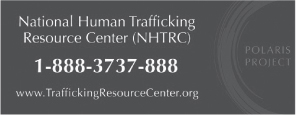Knowing what to look for and how to respond could save the life of a child.
AFTER READING THE OVERVIEWS and stories, I imagine your brain and emotions are on high alert to detect potential victims. This information can be very effective when used wisely—and equally dangerous when used emotionally and irresponsibly. With that in mind, I think it’s important to give you basic tools to identify, respond to, and report an incident accurately and safely. Note: Typically, no one indicator is enough to identify a victim—multiple indicators should be present.
• Truancy
• Clothing that is inappropriate for the weather or other conditions
• A demeanor that is either withdrawn, depressed, and fearful, or one that is confident and boasting
• The presence of an older, controlling boyfriend or female companion
• Being handled roughly or touched inappropriately
• Malnourished or eats as if ravenously hungry
• Sudden change in attire, behavior, possessions
• Branding, tattoos, or carvings
• Evidence of mutilation
• Scripted answers, inconsistent stories
• Frequent travel to other cities
• Varied stages of bruising, with clumps of makeup covering marks
• Possession of motel room cards, escort service cards, condoms, large amounts of cash, or gift cards
• Lack of proper documents (school identification, driver’s license, Social Security card)
• Use of terms common to the sex industry
• Stunted growth
• Poorly formed or rotted teeth
I would like to extend a sincere thank you to Deena Graves, founder of Traffick911, for providing me with a significant portion of these red flags.
• Call 911 if you believe a child is in immediate danger.
• Contact local law enforcement and give a description of the indicators just listed that lead you to believe the child is a trafficking victim.
• Traffickers are extremely dangerous criminals. Never approach a trafficker. Do not attempt to talk to a victim when she is under the direct supervision of a trafficker. Victims will be moved quickly if the trafficker suspects that he or she has been identified and will often suffer severe beatings for talking with people other than prospective clients.
• Always follow up your experience with a call to the National Human Trafficking Center for data collection purposes.

Hotline call specialists are available twenty-four hours a day to take reports from anywhere in the country related to potential trafficking victims, suspicious behavior, and locations where trafficking is suspected to occur. All reports are confidential. Interpreters are available.
If you are a professional who could come into contact with survivors of commercial sexual exploitation, I recommend that you take a look at these excellent resources:
• “Sex Trafficking: Identifying Cases and Victims,” National Institute of Justice, http://nij.gov/journals/262/Pages/sex-trafficking.aspx
• “Tools for Service Providers and Law Enforcement,” Polaris Project, http://www.polarisproject.org/resources/tools-for-service-providers-and-law-enforcement